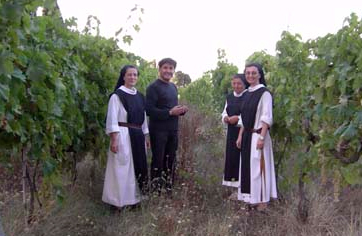Dr Vino's wine blog
wine talk that goes down easy
Ar.Pe.Pe. – mountain Nebbiolo
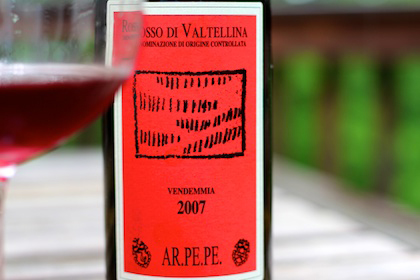
Nebbiolo, it’s not just for Piedmont! Well, actually it is just for Piedmont (think: Barolo, Barbaresco) since there are so few examples of the grape outside the region. But consider this example from Valtellina, in the adjacent region of Lombardy, slammed up against the alps and Switzerland.
Perched at about 4,200 ft altitude, the vineyards of producer Ar.Pe.Pe. are so steep that the grapes are harvested by a sort of modified ski gondola! And their steepness so rivals Hermitage that they also have signs in the vineyards in between terraces! It sounds outrageously cool and I am putting this on my list of places to visit. Fortunately, we can taste the fruits of these vineyards in the US today.
Ar.Pe.Pe.–an abbreviation for Arturo Pelizzatti Perego, pronounced “are pay pay”–provides a tasty treat with its Rosso Valtellina, 100% Nebbiolo fermented in stainless steel with brief aging in old oak barrels. The traditional producer makes more expensive, longer-aged reds, but this entry-level wine is ready to drink. I threw it in a decanter just for laffs, served it at 55 degrees and the transparent, light red color was appetizing in and of itself on a summer evening. Delicate fruit, stoniness, and the alluring slight bitterness of Nebbiolo, combine to make this wine (about $30) a stunner.
Red wines that chill
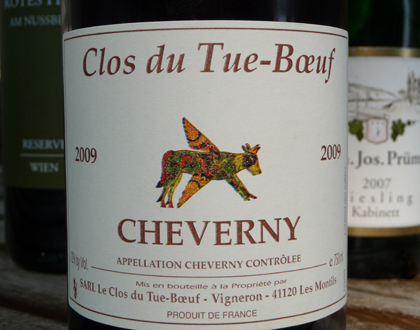
Chilled red. It sounds like an oxymoron. Or something that would get your membership revoked at the club.
But, in fact, it works. The key is to choose a red wine that is low in tannin, which explains why Beaujolais from the thin-skinned Gamay grape, often is the prime red candidate for chilling. Bringing the wine’s temperature down to say 55 degrees, gives the wine an added refreshment value (you can slip one of those ice sleeve things on for about 10 minutes). However, it does cut down on the wine’s fruity aromas–and also the perceived alcohol (which may be welcome depending on the wine in the glass). And if there are a lot of tannins in the wine, they stand out since that’s all that’s left.
Here are three reds worth a chill.
Clos du Tue-Boeuf, Cheverny (red), 2009. $15
The Puzelat brothers–leading natural winemakers–have made this delicious blend that combines the fruit and fun of gamay with a bit of the structure of pinot noir. I’ve poured this wine a lot this summer and it has won plaudits from wine geeks and newbies alike. Pour slowly or decant since this wine has thrown a sediment. (Bottled with extruded synthetic closure.)
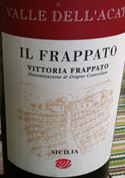 Valle dell’ Acate, Frappato, 2008, $20
Valle dell’ Acate, Frappato, 2008, $20
Similarly, I’ve poured this red native to Sicily wine a fair bit this summer–always chilled–and people love it! One group was intrigued by the idea of chilling red and the wine was gone way too fast. Another group suggested it reminded them of sangria–and meant that as a compliment. To me, it has bright red fruit but enough structure to be interesting. (Bottled with bright orange injection molded closure.)
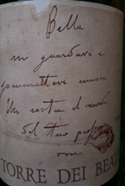 Torre dei Beati, Montepulciano d’Abruzzo Cerasuolo Rosa-ae, 2009 $18
Torre dei Beati, Montepulciano d’Abruzzo Cerasuolo Rosa-ae, 2009 $18
Technically, this wine is a rosé. But it’s a dark a rosé as you’ll encounter, so we’ll throw it in here with the chillable red since it also likes to chill. Hailing from (red) Montepulciano grapes in Abruzzo, to the east of Rome, the juice gets “bled” off after a couple days maceration. The resulting wine has notes of ripe cherries overlay surprisingly good acidity for this juicy, fun wine. (Bottled with cork.)
Coenobium – a hard to pronounce wine made by nuns
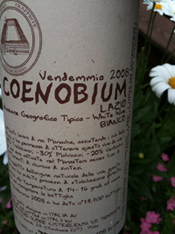 “Pass some more of the nun wine.”
“Pass some more of the nun wine.”
I overheard someone say that at the other end of my table recently. Not Blue Nun, mind you. But a wine actually made by nuns!
Since the Trappist monks in Belgium still make (and market) Chimay beer, I was pleased to discover that Trappist (Cistercian) nuns still make wine in Lazio, a little to the north of Rome.
The wine in question, Coenobium from the Monastero Suore Cistercensi, is a blend of Trebbiano, Malvasia, and Verdicchio. If you’re looking for a fresh, breezy, fruity, summer quaffer, look to other wines. This white has an oxidative quality that blankets layers of minerals, faint nuttiness, and acidity. The reason these grapes produce such complexity is in large part because the consultant winemaker, the acclaimed naturalista Giampiero Bea, has left the wine in contact with the skins, unusual for a white. They actually make another wine with even longer skin contact called “Rusticum.”
It’s a wine of contemplation that I happened to serve on my deck on a cool summer evening, a context that I think made it more appealing than on a searing hot day.
To finish off our unofficial women and wine week, here’s a picture of the nuns in the vineyards with Giampiero Bea.
